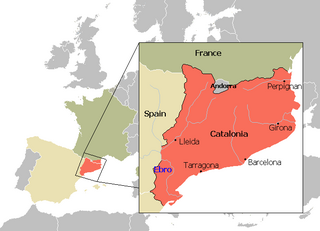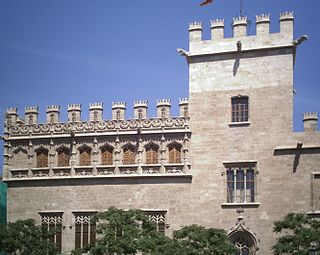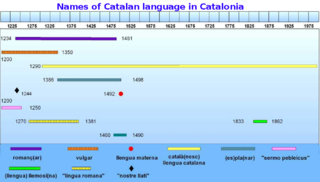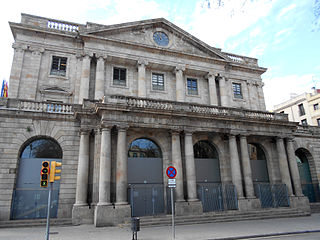
Catalan is a Western Romance language. It is the official language of Andorra, and an official language of three autonomous communities in eastern Spain: Catalonia, the Balearic Islands and the Valencian Community, where it is called Valencian. It has semi-official status in the Italian comune of Alghero, and it is spoken in the Pyrénées-Orientales department of France and in two further areas in eastern Spain: the eastern strip of Aragon and the Carche area in the Region of Murcia. The Catalan-speaking territories are often called the Països Catalans or "Catalan Countries".

James I the Conqueror was King of Aragon, Count of Barcelona, and Lord of Montpellier from 1213 to 1276; King of Majorca from 1231 to 1276; and King of Valencia from 1238 to 1276. His long reign of 62 years is not only the longest of any Iberian monarch, but one of the longest monarchical reigns in history, ahead of Hirohito but remaining behind Queen Elizabeth II, Queen Victoria, and Ferdinand III of Naples and Sicily.

Catalan cuisine is the cuisine from Catalonia. It may also refer to the shared cuisine of Northern Catalonia and Andorra, the second of which has a similar cuisine to that of the neighbouring Alt Urgell and Cerdanya comarques and which is often referred to as "Catalan mountain cuisine". It is considered a part of western Mediterranean cuisine.

Nosaltres, els valencians, is a historical and political essay by the Valencian (Spain) author Joan Fuster, first published in 1962.

The Crown of Aragon was a composite monarchy ruled by one king, originated by the dynastic union of the Kingdom of Aragon and the County of Barcelona and ended as a consequence of the War of the Spanish Succession. At the height of its power in the 14th and 15th centuries, the Crown of Aragon was a thalassocracy controlling a large portion of present-day eastern Spain, parts of what is now southern France, and a Mediterranean empire which included the Balearic Islands, Sicily, Corsica, Sardinia, Malta, Southern Italy, and parts of Greece.

The Principality of Catalonia was a medieval and early modern state in the northeastern Iberian Peninsula. During most of its history it was in dynastic union with the Kingdom of Aragon, constituting together the Crown of Aragon. Between the 13th and the 18th centuries, it was bordered by the Kingdom of Aragon to the west, the Kingdom of Valencia to the south, the Kingdom of France and the feudal lordship of Andorra to the north and by the Mediterranean Sea to the east. The term Principality of Catalonia was official until the 1830s, when the Spanish government implemented the centralized provincial division, but remained in popular and informal contexts. Today, the term Principat (Principality) is used primarily to refer to the autonomous community of Catalonia in Spain, as distinct from the other Catalan Countries, and usually including the historical region of Roussillon in Southern France.

The Consulate of the Sea was a quasi-judicial body set up in the Crown of Aragon, later to spread throughout the Mediterranean basin, to administer maritime and commercial law. The term may also refer to a celebrated collection of maritime customs and ordinances in Catalan language, also known in English as The Customs of the Sea, compiled over the 14th and 15th centuries and published at Valencia in or before 1494.

The Lonja de la Seda is a late Valencian Gothic-style civil building in Valencia, Spain. It is a principal tourist attraction in the city.

Santa Maria del Mar is a church in the Ribera district of Barcelona, Catalonia, Spain, built between 1329 and 1383 at the height of Principality of Catalonia's maritime and mercantile preeminence. It is an outstanding example of Catalan Gothic, with a purity and unity of style that is very unusual in large medieval buildings.

The military history of Catalonia began in the thirteenth century, with the first exploits of the armies under the orders of Catalan rulers and lasting until today, where Catalan soldiers are integrated into international forces.

The first names, or glossonyms, of the Catalan/Valencian language formed in a dialectal relation with Latin, in which Catalan existed as a variety. These names already expressed the relationship between the two languages. New names that related Catalan to Rome came about to dignify the Catalan language in the thirteenth century, though Latinists called it vulgar and the people planus, or pla.

The Valencian Community is an autonomous community of Spain. It is the fourth most populous Spanish autonomous community after Andalusia, Catalonia and the Community of Madrid with more than five million inhabitants. Its homonymous capital Valencia is the third largest city and metropolitan area in Spain. It is located along the Mediterranean coast on the east side of the Iberian Peninsula. It borders Catalonia to the north, Aragon and Castilla–La Mancha to the west, and Murcia to the south, and the Balearic Islands are to its east. The Valencian Community is divided into three provinces: Castellón, Valencia and Alicante.
The Ordinamenta et consuetudo maris was a convention governing maritime trade promulgated at Trani in 1063: "the oldest surviving maritime law code of the Latin West".

Maria Aurelia Capmany i Farnés was a Catalan novelist, playwright and essayist. She was also a prominent feminist cultural and anti-Franco activist.

Ricardo J. Vicent Museros was a Spanish printer and publisher. After studying in Germany he returned to Valencia with new methods of work, advertising and graphic marketing. He founded the "Museo Nacional de la Imprenta y la Obra Gráfica" in El Puig de Santa María. He promoted the twinning of the cities of Valencia and Mainz (Germany). In 1992, the International Gutenberg Society granted him the "Gutenberg Prize" and in 2003 he received the "Cross of Civil Merit" from the German government for his work in favour of cultural relations between Spain and Germany.

The History of the Catalan Navy is a book written by Arcadi García Sanz that glosses the Catalan Navy, in trade and war, its exploits and conquests, in a historical compilation that covers from Prehistory to this day. It describes the maritime battles, the Catalan sea consulates, to end by detailing aspects of maritime law, being the author a lawyer.

Memorias históricas sobre la marina, comercio y artes de la antigua ciudad de Barcelona.(Historical Records on marine, trade and arts of the ancient city of Barcelona) is a summary paper on the Navy, the trade and the arts of the city of Barcelona, written by the famous Antonio de Capmany y Montpalau.

An alhóndiga or almudí, almudín, alholí, public house or neighbors' market was formerly an establishment where grain was sold, bought and even stored, whose purpose was to help the neighbors and mainly the farmers in times of shortage. It is historically equivalent or derived from the caravanserais of the Muslim world.

The Catalan navy was a navy from the Principality of Catalonia. It encompassed the Catalan ships, Catalan admirals and Catalan crew, that were under the direct or indirect orders of the counts of Barcelona and represented a reality recognized throughout the Mediterranean from its origins in the 9th century, as stated by Einhard in Annales regni Francorum, until Ferdinand the Catholic. In later times, ships built and manned on the Catalan coast, even, some of them, under the authority of non-Catalan kings, such as the kings of Naples, staged some important events.

The Llotja de Barcelona or Llotja de Mar is a building located on Passeig d'Isabel II, in the La Ribera neighbourhood of Barcelona. The current 18th-century neoclassical building is considered one of the finest neoclassical building in Barcelona. Hidden within its walls, is the core of the original medieval llotja known as the saló de Contractacions, one of the finest civil gothic buildings in the Mediterranean. Originally conceived to provide merchants with a place for commercial transactions, it has also been used as a wheat store, an entertainment space, as a weapon magazine, a military barracks and the seat of the Consulate of the Sea and the Royal Barcelona Board of Trade. Today it houses the Cambra de Comerç and the Reial Acadèmia Catalana de Belles Arts de Sant Jordi.





















